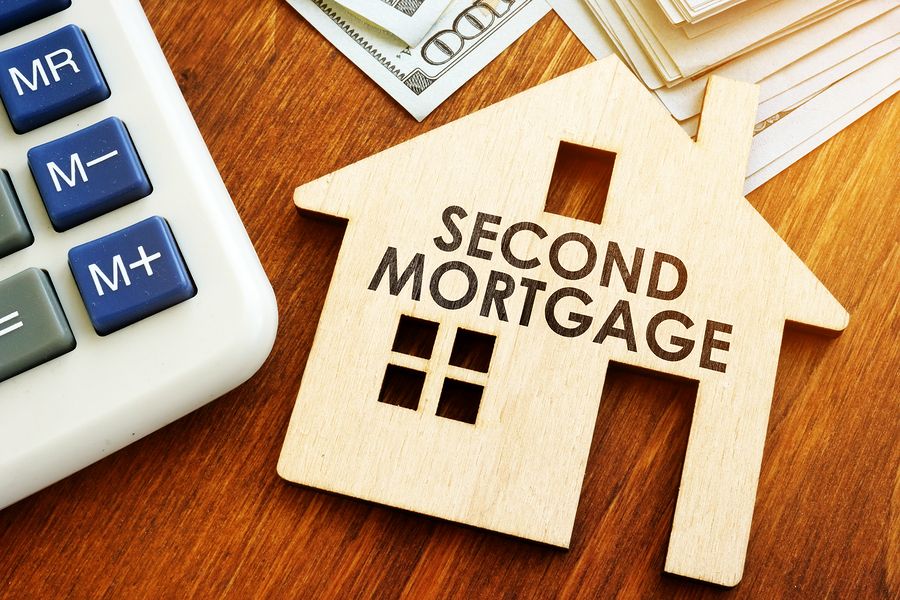- Introduction
- Second Mortgage Interest Rates
- Information
- Ontario Real Estate Market
- Mortgage Brokers
- Private Lenders
- Home Appraisers
- Mortgage Refinancing
- Private Mortgage Rates in [citylookup] for [monthyear]
- Second Mortgages - How Do They Work?
- Common Uses of Second Mortgages
- Tips for Getting a Second Mortgage
- How Much Can I Borrow?
- Using a Home Equity Line of Credit (HELOC)
- How Can you Qualify for a Second Mortgage?
- Helpful FAQ Post

A second mortgage is an additional mortgage that is placed on a property with an existing first mortgage. Second mortgages, also called 2nd mortgages, are considered riskier than first mortgages since if the property goes into default, the first mortgage holder must be paid first. Due to the increased risk, interest rates for second mortgages are typically more than those for first mortgages.
If you own at least 20% of the equity in your home, you will be approved for a second mortgage in Ontario. A second mortgage can provide money to renovate your home or even make capital available for your business. With a second mortgage, you can make your dreams come true by using an asset you already own.
We have many private mortgage lenders across Canada who have helped our clients receive second mortgages regardless of income or credit, based on the equity in their property. Call us to get the lowest second mortgage interest rate.
Second Mortgage Interest Rates
Second mortgage interest rates are higher than bank interest rates. To get the lowest interest rate on a second mortgage you will need a loan to value ratio below 65% and have enough income to cover the monthly interest payments. Second mortgage rates are also influenced by the location and the type of property. Most lenders prefer locations in towns and cities, rural areas and farms require a loan to value ratio below 50.0% to get a low-interest second mortgage.
Information
Ontario, located in east-central Canada is a province that borders the US and the Great lakes. Ottawa, Canada’s capital is located in Ontario and is known for Parliament Hill’s Victorian architecture and the National gallery. Ontario is Canada’s leading manufacturing province and its largest trading partner is the American state of Michigan. Ontario is conceptually divided into two regions, Northern Ontario and Southern Ontario. The majority of the province’s population is located in the south.
Ontario Real Estate Market
Ontario has always been a hot market for real estate. According to CREA, Average Prices and sales activity reached new heights in the first half of 2016 in Ontario, mainly in the GTA. Ottawa the nation’s capital seemed to have modest growth. It is also forecasted by CREA that sales activity should ease over the second half of the year in Ontario on a national basis.
Mortgage Brokers
A mortgage broker in Ontario acts as a link between a second mortgage lender and a borrower. It is the job of a mortgage broker to assess the borrower’s details to match the best mortgage product and rates associated with it. Mortgage Broker Store has the expertise and skills to grant you the best mortgage rates in the province. Call us today, so we can match the best second mortgage rates for you.
Private Lenders
When banks won’t finance your second mortgage loan, a private lender in Ontario may approve you even if you have a low income or bad credit. Private lenders will finance your second mortgage based on the equity in your home. Our Teams are connected with private second mortgage lenders in every city in Ontario who have approved second mortgages to many of our clients within just a few weeks.
Of all the different types of lenders, private mortgage lenders have the most lenient approval criteria. Private lenders will generally provide mortgages up to 75% of the value of the property. Most private lenders can only offer mortgages on typical residential homes worth at least $100,000. The ratio between the value of the requested mortgage and the value of the property is called a “Loan-to-Value” (LTV) ratio and is the main factor when it comes to approval on a private mortgage. These criteria are different from those of Banks, Trust Companies, and Credit Unions, which will also consider a borrower’s income ratios, employment, and credit score in addition to their LTV ratio. Private lenders are usually not concerned with the creditworthiness of the borrower.
Since private mortgages are considered to be a high-risk investment, these lenders demand higher rates and fees. A borrower can expect to pay rates between 7% to 12% and fees equal to 4% to 6% of the mortgage amount. The rates are dependent on the LTV ratio, while the fees are dependent on the complexity of the mortgage, which includes the cost of dealing with any legal issues. Approval can also depend on the location of the property, and in general, larger cities will have higher maximum LTV ratios. This rate estimation tool will take into account all of these factors and estimate what interest rate you can expect to pay for a mortgage.
Home Appraisers
While Mortgage brokers will help you in finding the best second mortgage rates, Home appraisal professionals will help you understand the value of your property. They will give you information on the recent selling prices of other homes in your area and how your home compares with them. Most lenders will require that a licensed home appraiser looks at a property before approving a mortgage.
Mortgage Refinancing
Mortgage refinancing lets you pay off your current loan by taking out a new one.
Refinancing helps you to consolidate debts into a single debt which in turn helps improve your credit rating. Refinancing also gets you a lower interest rate on your mortgage. A lower rate means lower payments. Thus, you will end up paying less for your home overall.
Call our team of mortgage brokers today to find out the best options for a Second mortgage loan or if you’re looking to Refinance.
For private mortgage lenders in Ontario the most important metric is the amount that is being borrowed relative to the value of the property. This metric is known as the Loan-to-Value value ratio. The closer this ratio is to the maximum the higher the interest rate will be. In Ontario the most someone can borrow is up to 75% of the appraisal value of the property.
| Amount Borrowed (LTV Ratio) | Expected Interest Rate for Ontario |
|---|---|
| Borrowing 75% of the property’s value | 11.99% |
| Borrowing 65% of the property’s value | 9.49% |
| Borrowing 50% of the property’s value | 8.49% |
Second Mortgages – How Do They Work?
A second mortgage works just like a prime mortgage, in that it’s a lump sum of money that’s applied to the purchase price of a home. Unlike a traditional mortgage, a second mortgage is taken out against a property that already has a mortgage on it.
One key thing to remember about second mortgages is that in the event of a default or power of sale, the lender of the original mortgage gets paid first, with any leftover funds from the sale of the home then going to the second mortgage lender. For this reason, second mortgages are riskier to the lender, and therefore often carry higher interest rates and additional fees to help mitigate that risk.
Common Uses of Second Mortgages
Second mortgages are frequently used to consolidate debt or refinance a mortgage. Sometimes, a borrower needs to refinance due to financial hardship or additional debts. Other times, a second mortgage can be a way to access lower interest rates after a market downturn or an improvement in your personal credit rating.
What happens to your mortgage if you find yourself unexpectedly laid off, or you get into a car accident that leaves you facing costly vehicle repairs? In many cases, borrowers simply don’t have the savings or financial leverage to continue making mortgage payments on schedule while covering emergency expenses.
While these types of situations can sometimes be remedied by working out a deferral or payment adjustment with your lender, a second mortgage might be considered as a “last resort” to effectively reset the mortgage.
Second mortgages can also be used to consolidate debt from multiple sources — for example, if you have a credit card or student loan debt along with your existing mortgage, you might use the lump sum from a second mortgage to pay off all those debts at once, thus consolidating your debt into a single source, and therefore a single monthly payment.
Second mortgages may also be used as a source of cash for major one-time expenses such as renovations or costs related to starting a business.
Tips for Getting a Second Mortgage
If you’re taking out a second mortgage from a private lender or an alternative lender, as long as you have at least 20 percent available equity in your home, you can usually get approved. Private and alternative lenders tend to focus mostly on the value of your property and your current income situation — not so much your credit score or history — so it can be easier to get approved by these types of lenders.
If you’re borrowing from a provincially regulated lender like a credit union or a trusted company, you’ll want to make sure that your credit score is at least fair (around 550), and that you can demonstrate steady income and a history of financial responsibility.
How Much Can I Borrow?
The maximum amount you can borrow in the form of a second mortgage is determined by the appraised value of your home and the amount still outstanding on your initial mortgage. To calculate your second mortgage maximum, take 80 percent of the appraised value of your home and subtract any amount still owed on your initial mortgage.
It’s usually a good idea to have your home appraised before applying for a second mortgage, especially if it’s been several years since you purchased the home. Many lenders of second mortgages roll appraisal fees into the application process.
As an example, imagine your home is worth $500,000 – 80 percent of $500,000 is $400,000. When you purchased the home, you took out a mortgage worth $300,000, and you’ve paid off $200,000. This means you have $100,000 still outstanding on your first mortgage. Subtract that $100,000 from $400,000, and you’re left with $300,000, the maximum amount you can borrow on your second mortgage.
Most borrowers don’t borrow the maximum amount on a second mortgage. Due to the higher fees and interest rates, it’s best to borrow only enough to cover your needs.
Using a Home Equity Line of Credit (HELOC)

A Home Equity Line of Credit, or HELOC, is a form of a home equity loan in which you borrow a revolving amount from the available equity in your home. Revolving loan functions similarly to a credit card, in that, amount that you repay immediately becomes available for you to use again.
A HELOC is technically registered as a mortgage debt, but it functions differently from a typical mortgage. HELOCS are often smaller than lump-sum mortgages, however, the revolving nature can be helpful as a way to pay off debts while covering other ongoing expenses like repairs, medical bills, or temporary income loss. Many homeowners use HELOCs as a regular income supplement, or a source of additional money to support repairs and renovations or holiday expenses. If a borrower misses a payment on their HELOC, typically the lender will demand the entire HELOC balance to be paid off in full. This is in contrast to a missed mortgage payment, where a lender will usually initially request just the missed payments to be repaid.
How Can you Qualify for a Second Mortgage?
Qualifying for a second mortgage is usually a matter of proving that you have equity in your home and that you have some source of income. As long as a lender can be reasonably certain of your ability to pay back the loan, you can get approved.
The more regulated a lender, the more qualifications you’ll likely need to meet. For example, if you’re borrowing from a private lender, the most important thing you need to prove is that your property is valuable — worth enough that the lender can be certain that they would recoup the costs through power of sale as a last resort. With credit unions and banks, you’ll need to have a strong credit score and a demonstrated history of using banking services responsibly. This can be more difficult since being in a position to take out a second mortgage often means that you’ve run into some financial difficulty.
Talk to your mortgage broker or a mortgage advisor before applying for any mortgage. Experts can help you determine what structure of loan will work best for your financial situation, and help guide you through the process from application to approval.
Helpful FAQ Post
How Does a Second Mortgage Work?
To understand how second mortgages work, it’s important to understand the function of mortgages in general. When you think of a mortgage, you’re probably thinking a structure similar to a traditional mortgage from a bank. These types of loans are usually called prime mortgages. Learn more on how a Second Mortgage works.
- Ajax
- Ancaster
- Aurora
- Barrie
- Belleville
- Bradford
- Brampton
- Brantford
- Burlington
- Caledon
- Cambridge
- Cornwall
- Etobicoke
- Georgina
- Guelph
- Haldimand County
- Halton Hills
- North York
- Kawartha Lakes
- Kingston
- Kitchener
- Markham
- Milton
- Mississauga
- Newmarket
- Niagara Falls
- Norfolk County
- North Bay
- Oakville
- Peterborough
- Pickering
- Quinte West
- Richmond Hill
- Sault Ste. Marie
- St. Catharines
- Sudbury
- Thunder Bay
- Timmins
- Toronto
- Waterloo
- Welland
- Whitby
- Windsor
- Hamilton
- London
- Ontario
- Oshawa
- Ottawa
- Scarborough
- Vaughan
